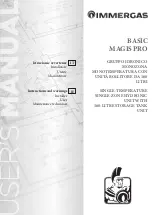
INSTALLATION
2-8
Whether using voltage or current for the drive
signal, they are linearly mapped to a 40
o
to
240
o
F setpoint or a 0% to 100% firing rate. No
scaling for these signals is provided
2.7.4 B.M.S. (PWM) IN
NOTE
Only BMS Model 168 can utilize Pulse
Width Modulation (PWM), not the BMS II
(Model 5R5-384).
These terminals are used to connect the
AERCO Boiler Management System (BMS)
Model 168 to the unit. The BMS Model 168
utilizes a 12 millisecond, ON/ OFF duty cycle.
This duty cycle is Pulse Width Modulated (PWM)
to control firing rate. A 0% firing rate = a 5% ON
pulse and a 100% firing rate = a 95% ON pulse.
2.7.5 SHIELD
The SHIELD terminals are used to terminate any
shields used on sensor wires connected to the
unit. Shields must only be connected to these
terminals.
2.7.6 mA OUT
These terminals provide a 4 to 20 mA output
that can be used to monitor setpoint ( 40
o
to
240
o
F), outlet temperature (30
o
to 240
o
F), or fire
rate (0% to 100%). This function is enabled in
the Configuration Menu (Chapter 3, Table 3.4).
2.7.7 RS-485 COMM
These terminals are used for RS-485 MODBUS
serial communication between the unit and an
external “Master” such as a Boiler Management
System or other suitable device.
2.7.8 EXHAUST SWITCH IN
These terminals permit an external exhaust
switch to be connected to the exhaust manifold
of the boiler. The exhaust sensor should be a
normally open type switch
(such as AERCO Part
No. 123463) that closes (trips) at 500
o
F.
2.7.9 INTERLOCKS
The unit offers two interlock circuits for
interfacing with Energy Management Systems
and auxiliary equipment such as pumps or
louvers. These interlocks are called the Remote
Interlock and Delayed Interlock (Fig. 2.9). The
wiring terminals for these interlocks are located
inside the I/O Box on the unit front panel. The
I/O Box cover contains a wiring diagram which
shows the terminal strip locations for these
interlocks labeled REMOTE INTL’K IN and
DELAYED INTL’K IN. Both interlocks, described
below, are factory wired in the closed position.
NOTE:
Both the Delayed Interlock and Remote
Interlock must be in the closed position to
allow the unit to fire.
2.7.9.1 REMOTE INTERLOCK IN
The remote interlock circuit (REMOTE INTL’K
IN) is provided to remotely start (enable) and
stop (disable) the Boiler if desired. The circuit is
24 VAC and comes factory pre-wired closed
(jumped).
2.7.9.2 DELAYED INTERLOCK IN
The delayed interlock circuit (DELAYED INTL’K
IN) is typically used in conjunction with the
auxiliary relay described in paragraph 2.8. This
interlock circuit is located in the purge section of
the start string. It can be connected to the
proving device (end switch, flow switch etc.) of
an auxiliary piece of equipment started by the
Boiler’s auxiliary relay. The delayed interlock
must be closed for the boiler to fire. If the
delayed interlock is connected to a proving
device that requires time to close (make), a time
delay (Aux Start On Dly) that holds the start
sequence of the boiler long enough for a proving
switch to make can be programmed. Should the
proving switch not prove within the programmed
time frame, the boiler will shut down. The Aux
Start On Dly can be programmed from 0 to 120
seconds. This option is locate in the
Configuration Menu (Chapter 3).
2.7.10 FAULT RELAY
The fault relay is a single pole double throw
(SPDT) relay having a normally open and
normally closed set of relay contacts that are
rated for 5 amps at 120 VAC and 5 amps at 30
VDC. The relay energizes when any fault
condition occurs and remains energized until the
fault is cleared and the CLEAR button is
depressed. The fault relay connections are
shown in Figure 2.9
2.8 AUXILIARY RELAY CONTACTS
Each Boiler is equipped with a single pole
double throw (SPDT) relay that is energized
when there is a demand for heat and de-
energized after the demand for heat is satisfied.
The relay is provided for the control of auxiliary
equipment, such as pumps and louvers, or can
be used as a Boiler status indictor (firing or not
Summary of Contents for AERCO Benchmark 2.0LN
Page 9: ... This page intentionally blank ...
Page 19: ... This page intentionally blank ...
Page 29: ... This page intentionally blank ...
Page 35: ... This page intentionally blank ...
Page 41: ...5 1 This page intentionally blank ...
Page 47: ...SAFETY DEVICE TESTING 6 1 This page intentionally blank ...
Page 70: ...APPENDIX C C 1 Temperature Sensor Resistance Chart Balco ...
Page 77: ...APPENDIX F F 2 ...
Page 78: ...APPENDIX F F 3 ...
Page 79: ...APPENDIX F F 4 ...
Page 92: ...APPENDIX G G 5 ...
















































